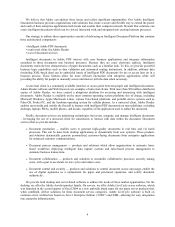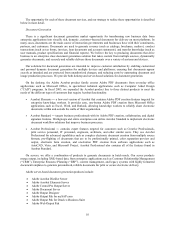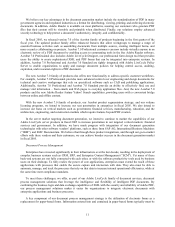Adobe 2004 Annual Report Download - page 19
Download and view the complete annual report
Please find page 19 of the 2004 Adobe annual report below. You can navigate through the pages in the report by either clicking on the pages listed below, or by using the keyword search tool below to find specific information within the annual report.19
In the higher end of the market, Acrobat Professional allows us to provide similar value as, and compete more
directly against, other creative professional PDF tool providers, such as Enfocus, Dalim, TeamPDF, and Zinio.
For document collaboration and document process management solutions, where electronic document delivery,
exchange, collaboration, and archival needs exist, our Intelligent Documents product family faces competition from
entrenched office applications such as Microsoft Office. In addition, some content management vendors provide
collaboration and business process management capabilities that could directly or indirectly compete with our
offerings, although we view our solutions in these areas as an extension of those supplied by such vendors.
Microsoft has also brought to market new products and technologies to address emerging Intelligent Documents
market needs. In the Professional version of Microsoft Office 2003, they introduced a new information gathering
program called InfoPath 2003. They have also introduced Windows Rights Management Services in their Windows
Server 2003 product, which is designed to allow corporate networks to manage and enforce restrictions built into
documents. Microsoft has also introduced enhanced collaborative document review, document security, and
document distribution capabilities in its versions of Microsoft Office 2003.
These new and updated Microsoft products and technologies, and their marketing initiatives supporting them,
indicate Microsoft is targeting the electronic document distribution, collaboration, and forms markets, markets that
we are also focused on.
In addition to Microsoft, and due to the large size of the document collaboration and document process
management opportunities, we have seen and expect to see new products and technologies from established
technology companies that may compete directly or indirectly with our Intelligent Document products and solutions.
We also continue to face competition in our Intelligent Documents business from small eForm solution
companies such as PureEdge, other regional based eForm solution providers, as well as FileNET’s electronic form
solutions. Similarly, we face competition for document process management solutions from workflow solution
vendors such as FileNET, MetaStorm, Scansoft, and Ultimus.
We believe that our Intelligent Documents product family competes favorably against these companies and
formats in terms of the combined benefits of superior functionality, cross-platform visual page fidelity/reliability,
multi-platform capability, file compression, printing and security of documents expressed using Adobe PDF. We
also believe that Adobe PDF and its integration with XML, combined with the broad distribution of Adobe Reader
on all leading hardware platforms, provide a ubiquitous universal multi-platform solution that is more compelling
than our competitors’ offerings.
Looking to the future, electronic document systems targeting enterprises will continue to be developed and will
likely be adopted. In addition, Microsoft is working on the next generation of its Windows operating system,
codenamed Longhorn, which could be released as early as late 2005. It is anticipated that Microsoft will add new
user interface and electronic document capabilities to Longhorn, potentially providing additional competition to our
Intelligent Document products and solutions. We are working to ensure our Adobe Intelligent Documents
applications stay at the forefront of innovation in emerging opportunities such as document generation, document
collaboration and document process management, and thus are positioned to be leading products and technologies in
these areas.
OEM PostScript and Other
We believe that the principal competitive factors for OEMs in selecting a page description language or a
printing technology are product capabilities, market leadership, reliability, price, support, and engineering
development assistance. We believe that our competitive advantages include our technology competency, OEM
customer relationships, and intellectual property portfolio. Adobe PostScript faces competition from
Hewlett-Packard’s proprietary PCL page description language, and from developers of other page description
languages based on the PostScript language standard, including Global Graphics and Xionics.
























